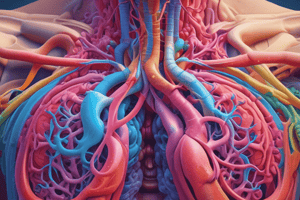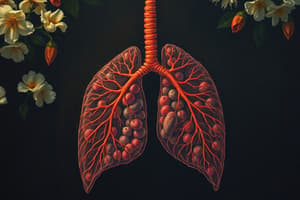Podcast
Questions and Answers
What is the primary purpose of gas exchange in organisms?
What is the primary purpose of gas exchange in organisms?
- To absorb nutrients
- To support cellular respiration (correct)
- To produce carbon dioxide
- To release stored energy
Which adaptation is essential for effective gas exchange in animals?
Which adaptation is essential for effective gas exchange in animals?
- Respiratory surfaces with limited contact with the environment
- Respiratory surfaces with a large surface area (correct)
- Thick respiratory surfaces
- Respiratory surfaces that are dry
What role does moisture play in gas exchange?
What role does moisture play in gas exchange?
- It facilitates the diffusion of gases. (correct)
- It limits the amount of oxygen available.
- It reduces the speed of gas molecules.
- It enhances the thickness of respiratory surfaces.
What is the conducting portion of the respiratory system responsible for?
What is the conducting portion of the respiratory system responsible for?
Which statement is true regarding the process of diffusion during gas exchange?
Which statement is true regarding the process of diffusion during gas exchange?
Which gas is primarily taken in during gas exchange to support cellular respiration?
Which gas is primarily taken in during gas exchange to support cellular respiration?
Why are respiratory surfaces designed to be thin?
Why are respiratory surfaces designed to be thin?
What waste product is generated through cellular respiration?
What waste product is generated through cellular respiration?
What structure acts as a guard for the opening to the larynx?
What structure acts as a guard for the opening to the larynx?
What happens to the epiglottis during normal breathing?
What happens to the epiglottis during normal breathing?
Which part of the respiratory system is responsible for sound production?
Which part of the respiratory system is responsible for sound production?
Which statement about vocal cords is correct?
Which statement about vocal cords is correct?
What is the function of the trachea in the respiratory system?
What is the function of the trachea in the respiratory system?
Which of the following structures branches into smaller tubes called bronchioles?
Which of the following structures branches into smaller tubes called bronchioles?
What is the primary role of alveoli in the respiratory system?
What is the primary role of alveoli in the respiratory system?
What directs substances into the esophagus during swallowing?
What directs substances into the esophagus during swallowing?
What occurs during inhalation in the respiratory system?
What occurs during inhalation in the respiratory system?
What primarily regulates the breathing rate in humans?
What primarily regulates the breathing rate in humans?
What happens during passive exhalation?
What happens during passive exhalation?
Which statement about the diaphragm is correct?
Which statement about the diaphragm is correct?
The respiratory center in the brain is primarily located in which part?
The respiratory center in the brain is primarily located in which part?
What contributes to the passive force needed for exhalation?
What contributes to the passive force needed for exhalation?
How is the breathing rate adjusted?
How is the breathing rate adjusted?
What happens to the chest cavity during inhalation?
What happens to the chest cavity during inhalation?
What is the primary location for gas exchange in the human respiratory system?
What is the primary location for gas exchange in the human respiratory system?
What role does surfactant play in the alveoli?
What role does surfactant play in the alveoli?
How many alveoli are approximately found in the two lungs of an average adult?
How many alveoli are approximately found in the two lungs of an average adult?
What type of cells primarily constitute the walls of the alveoli?
What type of cells primarily constitute the walls of the alveoli?
What enables gases to enter and leave the blood in the lungs?
What enables gases to enter and leave the blood in the lungs?
What structure covers most of the alveolar surface and facilitates gas exchange?
What structure covers most of the alveolar surface and facilitates gas exchange?
What do the epithelial cells of the alveoli and the endothelial cells of capillaries form together?
What do the epithelial cells of the alveoli and the endothelial cells of capillaries form together?
In which direction does oxygen diffuse during gas exchange in the lungs?
In which direction does oxygen diffuse during gas exchange in the lungs?
What percentage of oxygen in the blood is typically bound to hemoglobin?
What percentage of oxygen in the blood is typically bound to hemoglobin?
Which mechanism primarily accounts for the transport of carbon dioxide in the blood?
Which mechanism primarily accounts for the transport of carbon dioxide in the blood?
How does the binding of oxygen affect the structure of hemoglobin?
How does the binding of oxygen affect the structure of hemoglobin?
What is the effect of diffusion gradients on gas exchange in the lungs and body tissues?
What is the effect of diffusion gradients on gas exchange in the lungs and body tissues?
Which of the following statements about carbon dioxide transport is correct?
Which of the following statements about carbon dioxide transport is correct?
Flashcards
Respiration
Respiration
The process by which organisms exchange gases with the environment, taking in oxygen and releasing carbon dioxide, to support cellular respiration.
Cellular Respiration
Cellular Respiration
The process that converts energy in nutrients into ATP, requiring oxygen and producing carbon dioxide as a waste product.
Diffusion
Diffusion
The movement of molecules from areas of high concentration to areas of low concentration.
Why do respiratory surfaces need to be moist?
Why do respiratory surfaces need to be moist?
Signup and view all the flashcards
Why are respiratory surfaces thin?
Why are respiratory surfaces thin?
Signup and view all the flashcards
Why do respiratory surfaces need a large surface area?
Why do respiratory surfaces need a large surface area?
Signup and view all the flashcards
Conducting portion of the respiratory system
Conducting portion of the respiratory system
Signup and view all the flashcards
Gas-exchange portion of the respiratory system
Gas-exchange portion of the respiratory system
Signup and view all the flashcards
Conducting Portion
Conducting Portion
Signup and view all the flashcards
Pharynx
Pharynx
Signup and view all the flashcards
Larynx
Larynx
Signup and view all the flashcards
Epiglottis
Epiglottis
Signup and view all the flashcards
Vocal Cords
Vocal Cords
Signup and view all the flashcards
Trachea
Trachea
Signup and view all the flashcards
Bronchi
Bronchi
Signup and view all the flashcards
Alveoli
Alveoli
Signup and view all the flashcards
Breathing
Breathing
Signup and view all the flashcards
Inhalation
Inhalation
Signup and view all the flashcards
Exhalation
Exhalation
Signup and view all the flashcards
Diaphragm
Diaphragm
Signup and view all the flashcards
Rib muscles
Rib muscles
Signup and view all the flashcards
Respiratory center
Respiratory center
Signup and view all the flashcards
CO2 receptors
CO2 receptors
Signup and view all the flashcards
Breathing rate regulation
Breathing rate regulation
Signup and view all the flashcards
Gas exchange in the respiratory system
Gas exchange in the respiratory system
Signup and view all the flashcards
Hemoglobin
Hemoglobin
Signup and view all the flashcards
Bicarbonate ions (HCO3-)
Bicarbonate ions (HCO3-)
Signup and view all the flashcards
Color change of blood
Color change of blood
Signup and view all the flashcards
What are alveoli?
What are alveoli?
Signup and view all the flashcards
What is surfactant?
What is surfactant?
Signup and view all the flashcards
What is the respiratory membrane?
What is the respiratory membrane?
Signup and view all the flashcards
How does gas exchange work in the lungs?
How does gas exchange work in the lungs?
Signup and view all the flashcards
What are capillaries in the lungs?
What are capillaries in the lungs?
Signup and view all the flashcards
How do alveoli increase surface area?
How do alveoli increase surface area?
Signup and view all the flashcards
Why are capillaries important for gas exchange?
Why are capillaries important for gas exchange?
Signup and view all the flashcards
How thin are the walls of alveoli?
How thin are the walls of alveoli?
Signup and view all the flashcards
Study Notes
Respiration Overview
- Respiration is the process of gas exchange, crucial for cellular respiration
- Cellular respiration converts nutrients into energy (ATP), releasing CO₂ as a waste product, requiring a constant supply of oxygen
- Organisms exchange gases with the environment, taking in oxygen and releasing CO₂
Gas Exchange Requirements
- Gas exchange relies on diffusion
- Respiratory surfaces must be moist for gases to dissolve and diffuse
- Surfaces are thin to minimize diffusion distances
- Large surface area is needed for adequate gas exchange
Human Respiratory System
-
Divided into conducting and gas-exchange portions
-
Conducting portion: A series of passageways that carry air to and from the gas-exchange portion. Includes:
- Nasal or oral cavity
- Pharynx
- Larynx ("voice box")
- Epiglottis (a flap that protects the larynx during swallowing)
- Trachea
- Bronchi (that split into smaller bronchioles)
- Bronchioles that lead to alveoli (tiny air sacs)
-
Gas-exchange portion: This is within the lungs, where oxygen and carbon dioxide are exchanged with the blood.
Breathing Mechanics
- Inhalation is active, exhalation is passive.
- Inhalation:
- Diaphragm contracts, pulling downward
- Rib muscles contract, lifting the ribs
- Chest cavity enlarges
- Exhalation:
- Diaphragm relaxes, moving upward
- Rib muscles relax, ribs lowering
- Chest cavity shrinks
Breathing Control
- Breathing rate controlled by the respiratory center in the medulla
- Impulses from nerve cells stimulate diaphragm and rib muscle contractions
- Respiratory center receives input from various sources (e.g., CO₂ levels) to adjust breathing rate and volume as needed
Gas Exchange in Alveoli
- Occurs in the alveoli (tiny air sacs in the lungs)
- Alveoli have a thin layer of surfactant to prevent sticking and collapse
- A network of capillaries covers the alveoli's surface
- Walls consist of a single layer of epithelial cells, forming the respiratory membrane where gas exchange takes place
Blood Gas Transport
- Blood picks up oxygen from the lungs and delivers it to body tissues
- Simultaneously absorbs CO₂ from tissues and releases it into the lungs
- Oxygen:
- Binds to hemoglobin (a protein in red blood cells)
- About 98% bound to hemoglobin
- Hemoglobin changes shape when oxygen bonds
- Oxygenated blood is bright red, deoxygenated is maroon.
- Carbon Dioxide:
- Dissolved in plasma; bound to hemoglobin; converted into bicarbonate ions
- Conversion of CO2 to bicarbonate ions helps in transporting CO2 in blood.
Gas Exchange Summary
- Diffusion gradients between air in alveoli, blood in capillaries, and body tissues drive gas exchange.
- Oxygen diffuses from alveoli into the blood (high in alveoli, low in blood), CO₂ diffuses out of the blood into alveoli to be exhaled.
Studying That Suits You
Use AI to generate personalized quizzes and flashcards to suit your learning preferences.




